25 Best Native Plants for Charleston, SC
BY MELANIE JOSEPH | MAY 8TH, 2023 | CHARLESTON, LAWN CARE, SOUTH CAROLINAA city steeped in history and tradition, Charleston is also a city that’s evolving. One way in which it’s changing is in the way homeowners approach gardening and landscaping. Increasingly, people are now recognizing the value of native plants. Not only do they add to the beauty and biodiversity of the area, but they also have many practical advantages over non-native species:
- Adapted to local climate and soil conditions
- Provide food and shelter for local wildlife
- Require less water and fertilizer
- Help prevent erosion and improve soil quality
- Can reduce the need for pesticides
- Preserve the unique character of local ecosystems
From showy flowers to stately trees, discover the best native plants for Charleston that will help you create a beautiful and sustainable garden that will thrive in our unique climate and soil.
In this article, we’ll cover:
- 25 Best Native Plants for Your Charleston Yard
- American Beautyberry
- American Fringe Tree
- Black-Eyed Susan
- Blazing Star
- Butterfly Weed
- Carolina Jessamine
- Dwarf Azalea
- Ear-Leaved Tickseed
- Eastern Redbud
- Florida Anise
- Florida Leucothoe
- Goldenrod
- Inkberry Holly
- Japanese Camellia
- Oakleaf Hydrangea
- Red Maple
- Sabal Palmetto
- Sea Oats
- Southern Lady Fern
- Southern Live Oak
- Southern Magnolia
- Southern Wax Myrtle
- Virginia Creeper
- Virginia Sweetspire
- Wild Indigo
- How to Choose Native Plants for Your Charleston Landscape
- FAQ About Native Charleston Plants
- Where to Find Native Plants in Charleston
25 Best Native Plants for Your Charleston Yard
1. American Beautyberry (Callicarpa Americana)
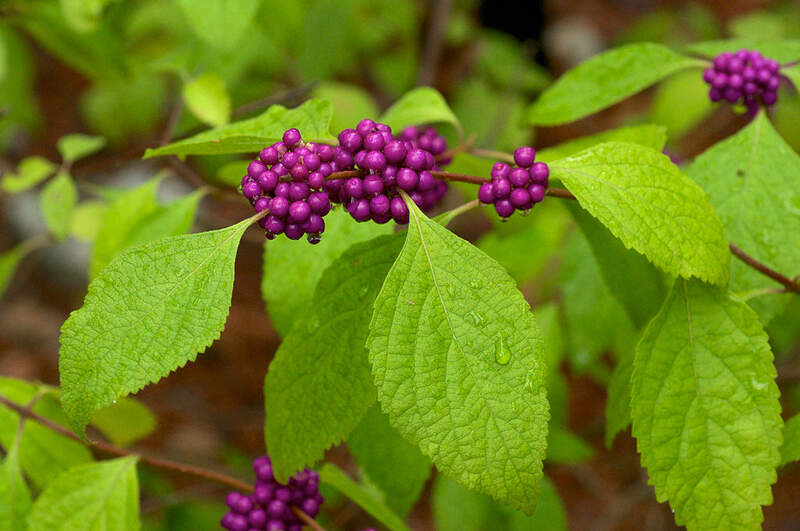
Photo Credit: Eric Hunt / Wikimedia Commons / CC BY-SA 3.0
Native to the southeastern United States, this deciduous shrub is a treasured addition to any Charleston garden. From August to November, bright purple berries cluster along its stems, making the American beautyberry a stunning focal point in any landscape design. In the fall, its green, toothed leaves turn yellow, creating a beautiful contrast with the berries.
It’s an excellent understory shrub that you can plant under large trees. And while this slow-growing plant takes several years to reach its full size, it can thrive for many years once established. Plus, it’s relatively easy to grow and requires minimal care. The berries are a favorite among local bird species, making American beautyberry a fantastic choice for birdwatchers.
Growth habit: Shrub
USDA Hardiness Zone: 6b-11
Mature size: 3-8 feet tall, 4-8 feet wide
Duration: Perennial
Foliage: Deciduous
Sunlight needs: Full sun and partial shade – needs at least four hours of exposure to direct sunlight per day
Soil preferences: Grows best in rich, organic loam soil but can tolerate a range of soil conditions
Water needs: Low – around 1 inch per week (during dry periods, it may need slow, deep watering)
Potential hazards: Non-toxic, but its berries can cause vomiting and other unpleasant symptoms if ingested
2. American Fringe Tree (Chionanthus virginicus)
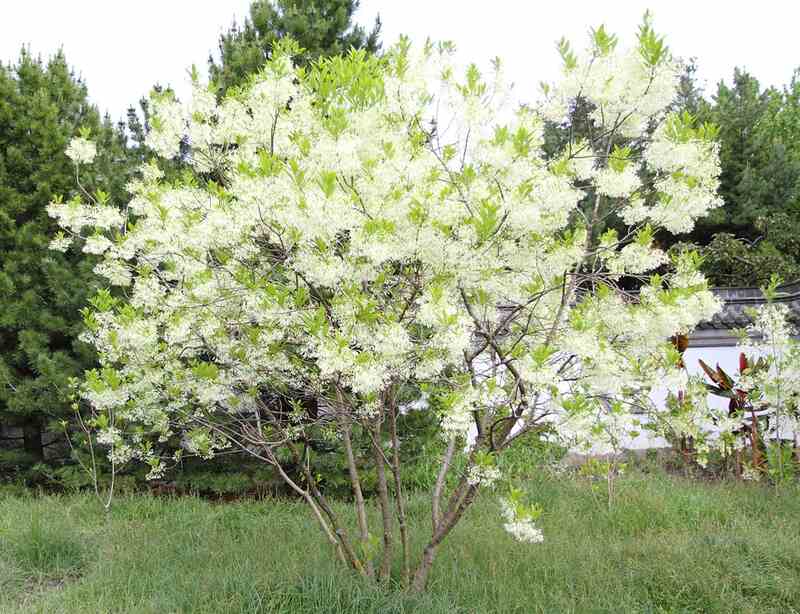
Photo Credit: Cephas / Wikimedia Commons / CC BY-SA 3.0
Also known as the sweetheart tree, the American fringe tree adds a touch of elegance to any landscape. This deciduous tree blooms from late spring to early summer with delicate, showy white flowers. Its bark is smooth and gray, while its leaves are shiny, dark green, and up to 8 inches long.
You can spot fringe trees in various locations throughout Charleston, including parks, gardens, and natural areas. It prefers moist, well-drained soils but can tolerate drier conditions once established. The tree is also relatively low-maintenance, making it an excellent choice for beginner gardeners.
Growth habit: Tree
USDA Hardiness Zone: 4-9
Mature size: 12-20 feet tall and 10-15 feet wide
Duration: Perennial
Foliage: Deciduous
Sunlight needs: Partial shade or full sun
Soil preferences: Well-drained, moist, loose, sandy, acidic soil
Water needs: Moderate – it’s a bit drought-tolerant
Potential hazards: While this tree is generally considered safe, note that all parts of the plant are toxic if ingested.
3. Black-Eyed Susan (Rudbeckia hirta)
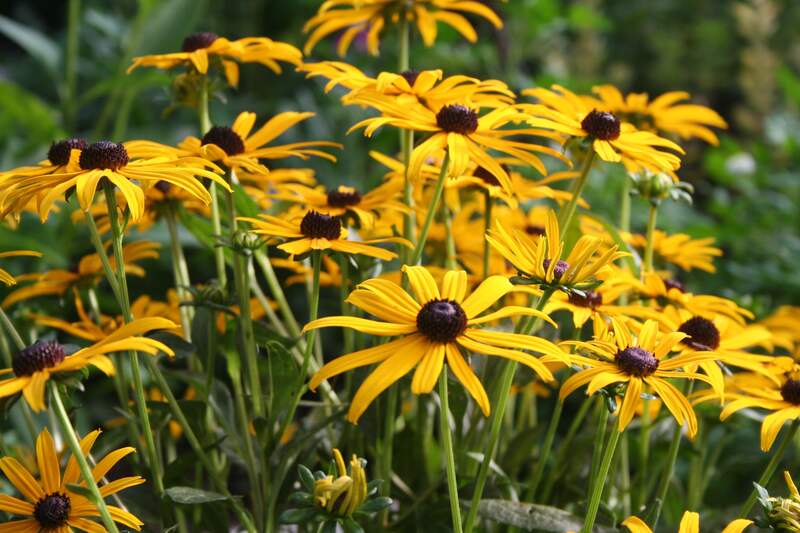
Photo Credit: Pxfuel
A stunning wildflower native to the eastern United States, black-eyed Susan is a great choice for anyone looking to add vibrant color to their garden. It blooms from early summer through fall, showing bright yellow petals with a dark center disk. It’s also perfect for Charleston’s hot summers, as it can tolerate drought well.
Black-eyed Susan is a relatively low-maintenance and deer-resistant plant, which is a big plus for gardeners dealing with wildlife. It attracts beneficial insects that can help control garden pests, such as ladybugs and lacewings.
As it can grow wild in open fields and meadows, black-eyed Susan can be used for mass plantings – its stunning display of yellow flowers can brighten up any landscape.
Growth habit: Wildflower
USDA Hardiness Zone: 3-9
Mature size: 2-4 feet
Duration: Biennial, annual, or short-lived perennial (depending on growing conditions)
Foliage: Deciduous
Sunlight needs: Partial shade to full sun – but it blooms best with at least six hours of direct sunlight each day
Soil preferences: Well-drained, acidic, sandy, loamy, fertile soil
Water needs: Low
Potential hazards: While it’s not toxic to humans and pets, it can cause asthma attacks and allergic skin reactions.
4. Blazing Star (Liatris spicata)
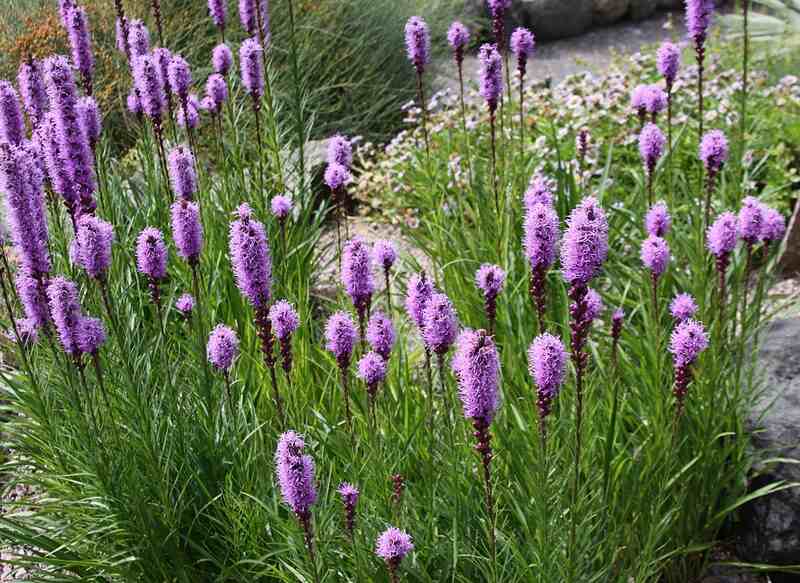
Photo Credit: Drew Avery / Wikimedia Commons / CC BY 2.0
Blazing star is a striking perennial wildflower that adds a burst of color to any garden. This tall, slender plant blooms from mid-summer to early fall and features spikes of purple flowers, making it a popular choice for late-season gardens.
Native to the eastern United States, blazing star is drought-tolerant and can survive hot, dry summers. They’re planted in many public gardens and natural areas throughout the city. And if you want to add height and vertical interest to your landscape, this perennial wildflower is perfect.
One of the best things homeowners love about the blazing star is its ability to attract pollinators, such as butterflies, bees, and hummingbirds. Its bright flowers provide a rich source of nectar, making it an essential plant for supporting local wildlife. In fact, it’s the preferred nectar source of both silver-spotted skipper and monarch butterflies.
Growth habit: Wildflower
USDA Hardiness Zone: 3-9
Mature size: 2-4 feet tall, 1-2 feet wide
Duration: Perennial
Foliage: Deciduous
Sunlight needs: Partial shade to full sun – it grows well in areas that get 6 or more hours of sun exposure a day
Soil preferences: Well-drained, moist, loamy soil
Water needs: Low
Potential hazards: Non-toxic, but it’s not recommended to ingest its leaves and flowers
5. Butterfly Weed (Asclepias tuberosa)
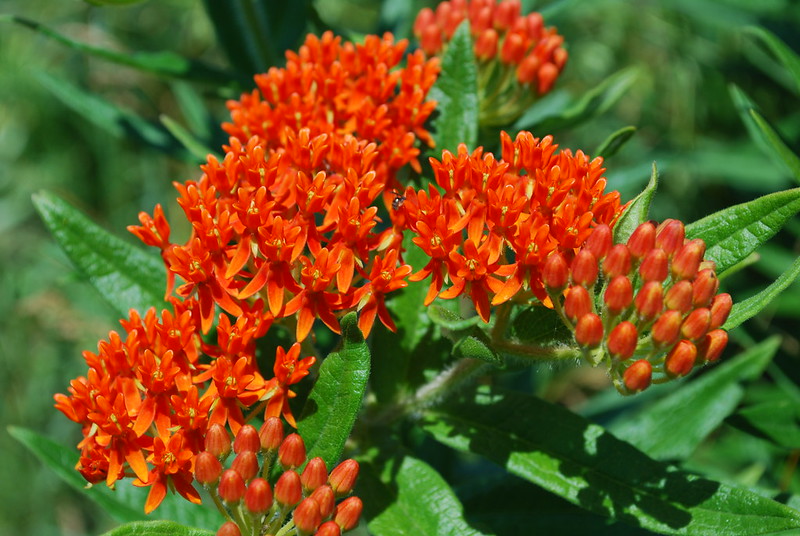
Photo Credit: Joshua Mayer / Flickr / CC BY-SA 2.0
As its name indicates, butterfly weed is a magnet for butterflies and other pollinators, making it an essential addition to any pollinator garden. This herbaceous perennial is part of the milkweed family and boasts striking clusters of bright orange flowers that bloom from June to August.
The flower clusters at the tips of this plant’s upright stems are long-lasting and add color to any garden border or flower bed. Its narrow leaves and stems are bright green, adding to its visual appeal.
Butterfly weed prefers well-draining soil and full sun, making it a perfect fit for the climate in Charleston. It’s also relatively drought-tolerant and requires minimal maintenance. Note, though, that it’s toxic if ingested, so it’s not a good choice for gardens with pets or small children.
Growth habit: Wildflower
USDA Hardiness Zone: 4-10
Mature size: 1-2 feet tall
Duration: Perennial
Foliage: Deciduous
Sunlight needs: Full sun
Soil preferences: Well-drained, sandy soil
Water needs: Low
Potential hazards: All parts of this plant are toxic and can even be fatal if consumed in large amounts
6. Carolina Jessamine (Gelsemium sempervirens)
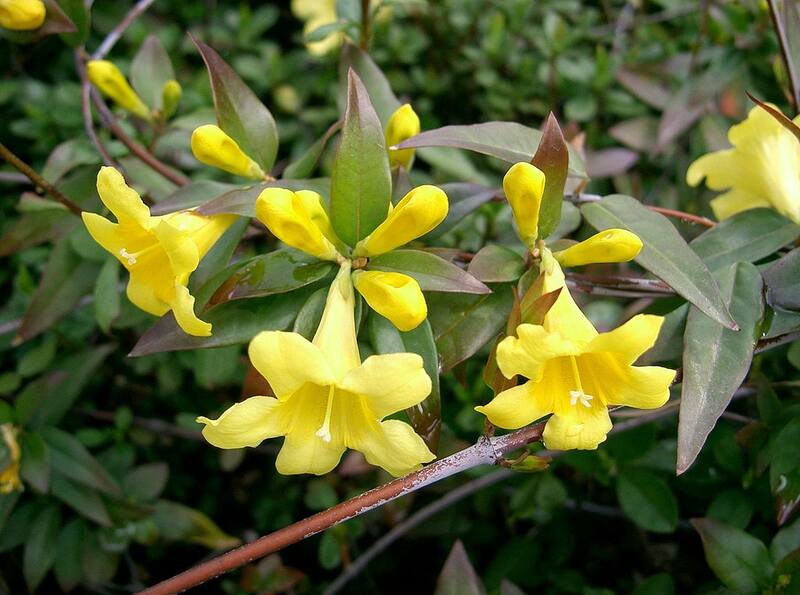
Photo Credit: KENPEI / Wikimedia Commons / CC BY-SA 3.0
Also known as Carolina yellow jasmine, this evergreen vine is perfect for Charleston’s hot and humid climate. And who wouldn’t want South Carolina’s state flower planted in their garden? The plant is a fast grower and can reach heights of up to 20 feet, making it an excellent choice for trellises, fences, or even as a ground cover.
One of the best things about Carolina Jessamine is its low maintenance requirements. This vine is adaptable to a wide range of soil types and thrives in full sun or partial shade. Bright yellow trumpet-shaped flowers bloom from late winter to early spring. Additionally, Carolina Jessamine is a great plant for attracting bees, butterflies, and hummingbirds to your garden.
However, all parts of the plant – especially the seeds and roots – are toxic if ingested. So you might want to go with other plants if you have pets and small children.
Growth habit: Vine
USDA Hardiness Zone: 6-10
Mature size: 10-20 feet tall
Duration: Perennial
Foliage: Evergreen
Sunlight needs: Full sun to partial shade – it can grow even with just 2-6 hours of direct sunlight a day
Soil preferences: Well-drained, moist, loamy soil with high organic matter
Water needs: Moderate
Potential hazards: All its parts are toxic if ingested, and its sap can cause allergic skin reactions in some people
7. Dwarf Azalea (Rhododendron atlanticum)
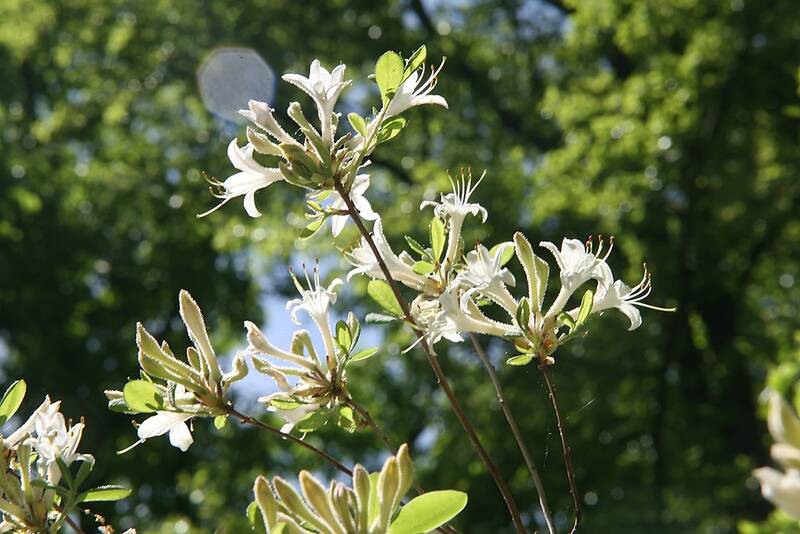
Photo Credit: David J. Stang / Wikimedia Commons / CC BY-SA 4.0
Sometimes called coastal azalea, the dwarf azalea is a compact and low-growing shrub that can add a splash of color to any garden. From April to May, it blooms stunning flowers in shades of pink, white, and red.
In Charleston, you’ll find dwarf azaleas planted in gardens, parks, and along sidewalks. The Magnolia Plantation and Gardens is a popular spot to see these plants, as they feature over 20 acres of stunning gardens that include a wide range of azaleas.
If you are growing dwarf azaleas in your own garden, note that they prefer well-draining soil and plenty of sunlight. They also require regular watering, particularly during dry spells.
Growth habit: Flowering shrub
USDA Hardiness Zone: 6a-8b
Mature size: 2-6 feet tall
Duration: Perennial
Foliage: Deciduous
Sunlight needs: Partial shade to full sun
Soil preferences: Well-drained, moist, acidic, sandy soil
Water needs: Moderate
Potential hazards: All parts of this plant are highly poisonous and can cause progressive paralysis, coma, and cardiac failure.
8. Ear-Leaved Tickseed (Coreopsis auriculata)
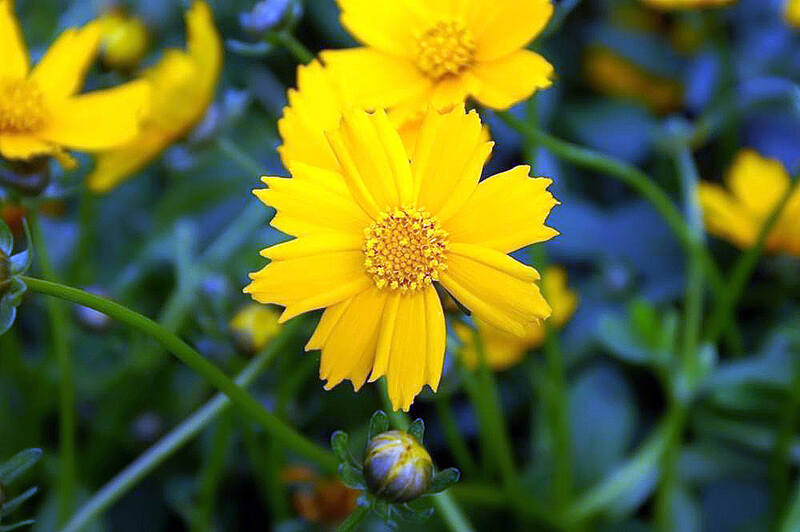
Photo Credit: David J. Stang / Wikimedia Commons / CC BY-SA 4.0
Easily recognizable by its sunny yellow blooms with black centers, the ear-leaved tickseed is a popular native wildflower well-suited to the Charleston area. This plant is part of the daisy family, and it’s known for its vibrant blooms that can be seen from late spring to early fall.
The natural habitat of this flowering plant includes meadows, prairies, and savannas. It’s also commonly planted in gardens and along roadsides. With its delicate foliage and bright flowers, it’s no surprise that the ear-leaved tickseed is a favorite among gardeners and landscapers alike.
To make the most of this beautiful plant, consider planting it in large masses or drifts. The ear-leaved tickseed looks best when planted in groups, which can create a stunning visual impact. You can add it to a wildflower meadow or a naturalized area of your garden. It’s an excellent plant for providing nectar for pollinators, while its seed is food for songbirds.
Growth habit: Wildflower
USDA Hardiness Zone: 4a-9b
Mature size: 1-2 feet tall
Duration: Perennial
Foliage: Deciduous
Sunlight needs: Partial shade to full sun
Soil preferences: Sandy or loamy soil
Water needs: Low
Potential hazards: Non-toxic
9. Eastern Redbud (Cercis canadensis)
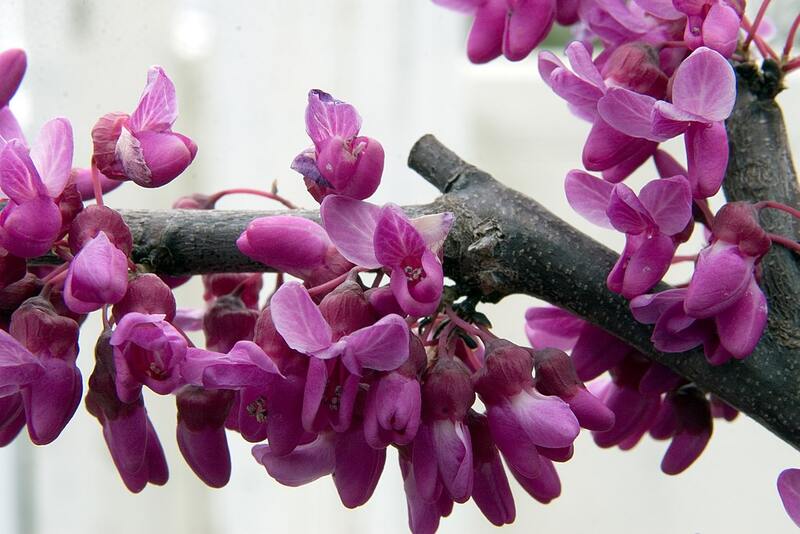
Photo Credit: David J. Stang / Wikimedia Commons / CC BY-SA 4.0
Native to the southeastern United States, Eastern redbuds can be found in the understory of forests or along the edges of woodlands. Its heart-shaped leaves and distinctive bark add visual appeal, and in the fall, the leaves turn a bright yellow before falling off.
If you visit White Point Garden and Hampton Park, it’s impossible not to stop and adore the beauty of the Eastern redbuds planted there, as this perennial tree is a showstopper in any garden. Its vibrant pink flowers bloom in early spring, adding a pop of color to landscapes.
As an early bloomer, the Eastern redbud is a vital source of nectar for bees, butterflies, and hummingbirds. Its showy flowers attract pollinators, making it a great addition to any garden aimed at supporting local wildlife. Homeowners looking to maximize the tree’s aesthetic impact can underplant with low-growing perennials such as creeping phlox or Virginia bluebells.
Pruning can help maintain this deciduous tree’s naturally attractive shape and prevent it from becoming too leggy. Also, monitor for pests and diseases, such as canker or Verticillium wilt, which can weaken or kill the tree if left unchecked.
Growth habit: Tree
USDA Hardiness Zone: 4-9
Mature size: 20-30 feet tall and 25-35 feet wide
Duration: Perennial
Foliage: Deciduous
Sunlight needs: Partial shade to full sun
Soil preferences: Well-drained, moist, nutrient-rich soil
Water needs: Moderate – Maintain the moisture level of the soil at a depth of 2-3 inches. Water at least once every week, depending on your soil type.
Potential hazards: Its saponin can be toxic to fish but is generally safe for humans or pets unless consumed in large amounts.
10. Florida Anise (Illicium floridanum)
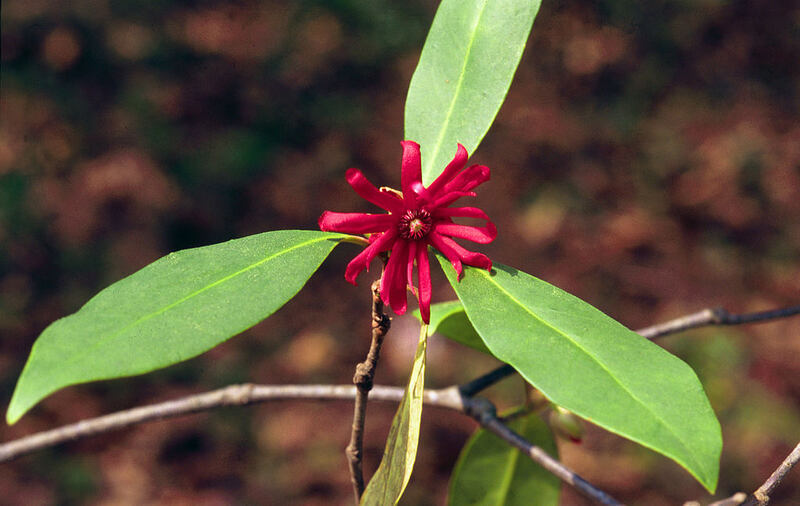
Photo Credit: Ted Bodner / Wikimedia Commons / CC BY 3.0 US
Prized for its glossy, leathery leaves and striking star-shaped flowers, Florida anise is an evergreen shrub native to the southeastern United States. Blooming in early spring, the plant’s beautiful, dark red flowers attract various pollinators, including bees and butterflies. Its sweet fragrance, reminiscent of licorice, is a favorite among hummingbirds.
This native shrub is commonly found in parks and gardens throughout Charleston, including Magnolia Plantation and Gardens, where it is a staple of the beautiful Camellia Collection. They naturally grow in wetlands and along stream banks, where they can grow up to 15 feet tall. In the garden, however, Florida anise can be pruned to a more manageable size and shaped into an attractive hedge.
To make the most of this deer-resistant shrub, you can incorporate it into your garden bed, using it as a focal point or an accent plant. You can plant it alongside other native species, such as the American beautyberry, to create a colorful and diverse garden.
Growth habit: Shrub
USDA Hardiness Zone: 8-10
Mature size: 10-15 feet tall, 6-10 feet wide
Duration: Perennial
Foliage: Evergreen
Sunlight needs: Partial shade to full sun
Soil preferences: Well-drained, moist, rich, loamy, clay, or sandy soil
Water needs: Low – it’s drought-tolerant, but you may need to water it weekly during extended dry periods
Potential hazards: Toxic – remember that it’s not the same as the star anise spice, and it’s poisonous if ingested by humans and pets.
11. Florida Leucothoe (Agarista populifolia)
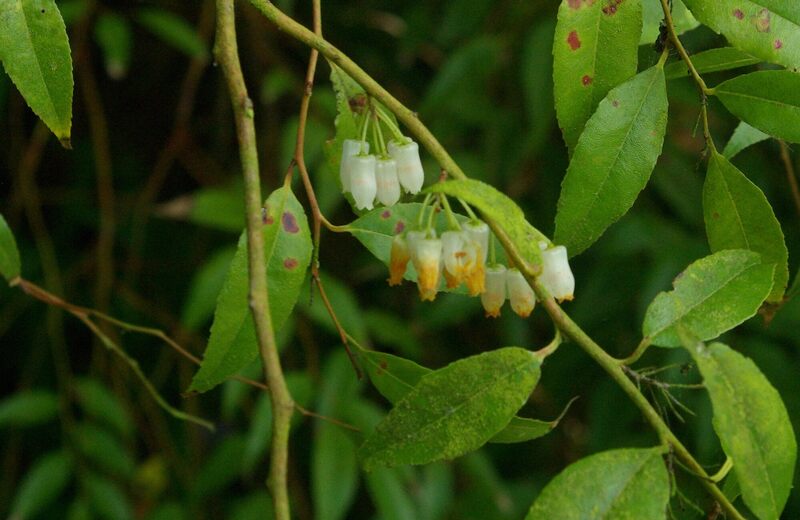
Photo Credit: El Funcionario / Wikimedia Commons / CC BY-SA 4.0
This native evergreen shrub is well-suited for the warm and humid climate of the region. Commonly found in wooded areas and swamps, Florida Leucothoe is a perfect addition to natural or woodland gardens. It prefers well-draining soil and partial to full shade but can tolerate some sun exposure with proper care.
Its glossy leaves have a striking bronze-green color when young and turn deep green as they mature, creating a beautiful contrast with its clusters of small, bell-shaped flowers that bloom in the spring. These flowers have a delicate fragrance and are usually white but can appear in shades of pink or red.
Florida Leucothoe is not only aesthetically pleasing but also provides habitat and food for various wildlife, such as butterflies and bees. To make it more beautiful in the garden, you can prune it regularly to maintain its shape and encourage bushier growth. You can plant it alongside other shade-loving plants, such as azaleas, ferns, and hostas, to create a stunning and harmonious display.
Growth habit: Shrub
USDA Hardiness Zone: 7a-9b
Mature size: 8-12 feet tall
Duration: Perennial
Foliage: Evergreen
Sunlight needs: Partial shade to full shade – can grow well even with less than 2 hours to no sun exposure
Soil preferences: Moist, fertile, acidic, loamy soil
Water needs: Moderate – remember not to overwater
Potential hazards: Highly Toxic – can be fatal to humans and animals if ingested
12. Goldenrod (Solidago species)
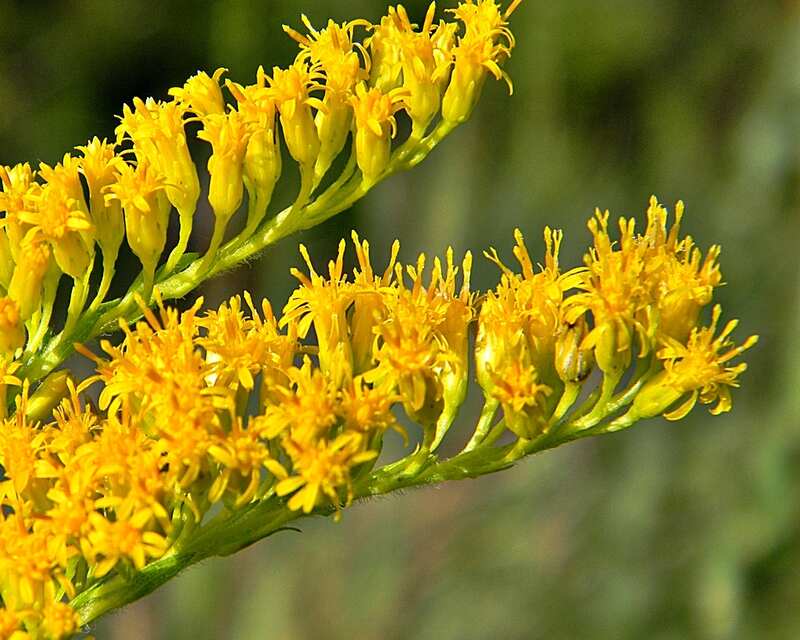
Photo Credit: Bob Peterson / Wikimedia Commons / CC BY-SA 2.0
A vibrant perennial native to the southeastern United States, goldenrod is known for its golden-yellow flowers that bloom in late summer and early fall. You can find it growing wild in fields, meadows, and along roadsides.
Goldenrod is an essential food source for bees and butterflies. Its nectar-rich flowers attract a wide variety of pollinators, providing a vital food source for them as they prepare for the winter months. It’s also a host plant for many species of caterpillars, making it an important part of the local ecosystem.
This hardy plant can tolerate dry conditions, making it a great choice for areas with hot summers, like Charleston. When planting it in your garden, give goldenrod plenty of space to grow. You can plant it in groups for a bold display of color.
Mix it with other late-blooming perennials, such as asters and Joe-Pye weed, for a stunning fall garden display. Regular deadheading can help keep the plant looking tidy and encourage more blooms.
Growth habit: Wildflower
USDA Hardiness Zone: 2a-8b
Mature size: 2-3 feet tall
Duration: Perennial
Foliage: Deciduous
Sunlight needs: Full sun
Soil preferences: Well-drained, acidic, fertile, clay, or loamy soil
Water needs: Moderate
Potential hazards: Non-toxic, but should not be ingested by pregnant or breastfeeding women as well as people with medical conditions
13. Inkberry Holly (Ilex coriacea)
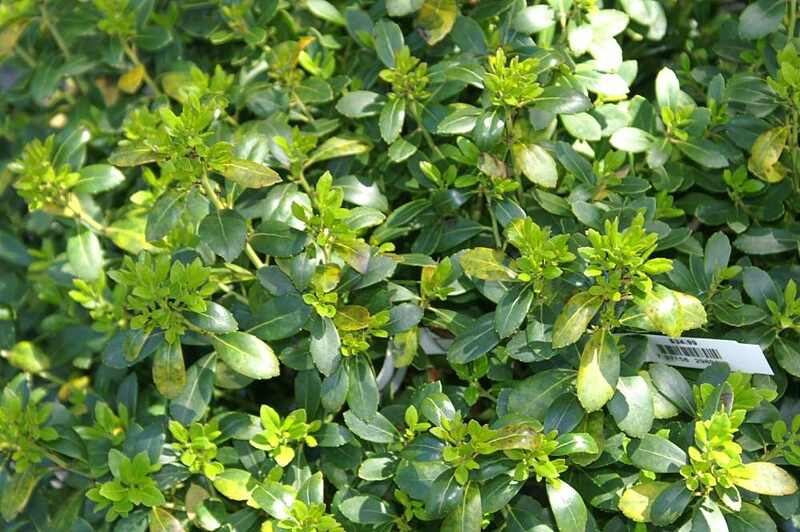
Photo Credit: David J. Stang / Wikimedia Commons / CC BY-SA 4.0
A versatile shrub that can add year-round interest to any garden, inkberry holly is popular among homeowners for its evergreen foliage and easy-to-grow nature. It can spread up to 8 feet wide, making it a great choice for hedges or privacy screens.
The shrub produces small, insignificant flowers in early summer, but it’s the glossy, dark green leaves that are the real star of the show. In the fall, the foliage may turn a purplish hue before becoming dark green again in the winter. The fruits of the inkberry holly are black and provide a food source for birds in the winter.
To make it even more attractive in your garden, consider planting inkberry holly in groups or using it as a backdrop for other flowering plants. Pruning can be done in early spring to encourage dense growth and maintain a tidy shape.
Growth habit: Shrub
USDA Hardiness Zone: 6a-9b
Mature size: 10-15 feet tall
Duration: Perennial
Foliage: Evergreen
Sunlight needs: Partial shade to full sun
Soil preferences: Moist, sandy, loamy soil
Water needs: High
Potential hazards: Its berries can be toxic to both humans and pets, while the spines in its leaves can be harmful when touched.
14. Japanese Camellia (Camellia japonica)
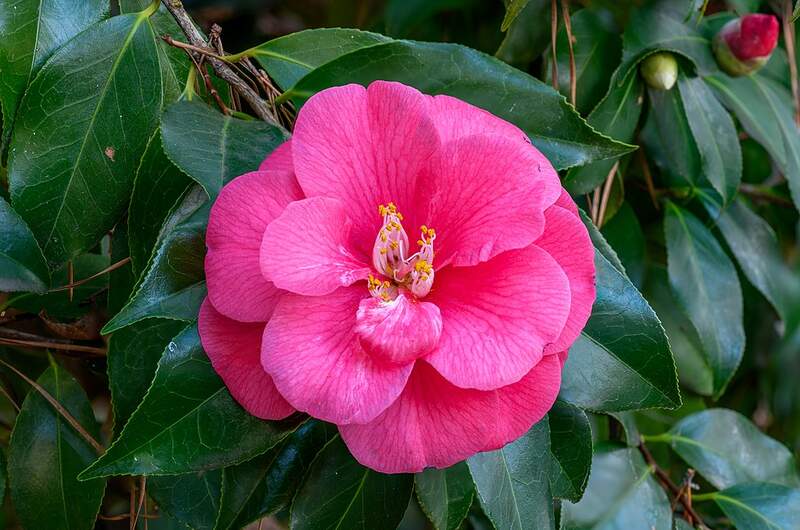
Photo Credit: PumpkinSky / Wikimedia Commons / CC BY-SA 3.0
The Japanese camellia is a popular ornamental shrub due to its attractive evergreen foliage and beautiful flowers. This flowering plant is native to Japan, where it has been cultivated for centuries, but it is now widely grown in temperate regions around the world.
In Charleston, Japanese camellias can be found in various parks and gardens, including the Magnolia Plantation and Gardens, the Middleton Place Gardens, and the Charleston Parks Conservancy.
Japanese camellia blooms in late winter or early spring, providing a welcome splash of color to the garden during the dreary winter months. Its showy flowers can be red, pink, white, or a combination of these colors, and they are often very large, up to 5 inches in diameter. The blooms are fragrant, which makes them even more attractive to pollinators.
Growth habit: Shrub
USDA Hardiness Zone: 7a-9b
Mature size: 10-13 feet tall
Duration: Perennial
Foliage: Evergreen
Sunlight needs: Partial shade or dappled sun
Soil preferences: Well-drained, moist, fertile, acidic soil
Water needs: Moderate – it’s relatively drought-tolerant but may require frequent watering during dry spells
Potential hazards: Non-toxic
15. Oakleaf Hydrangea (Hydrangea quercifolia)
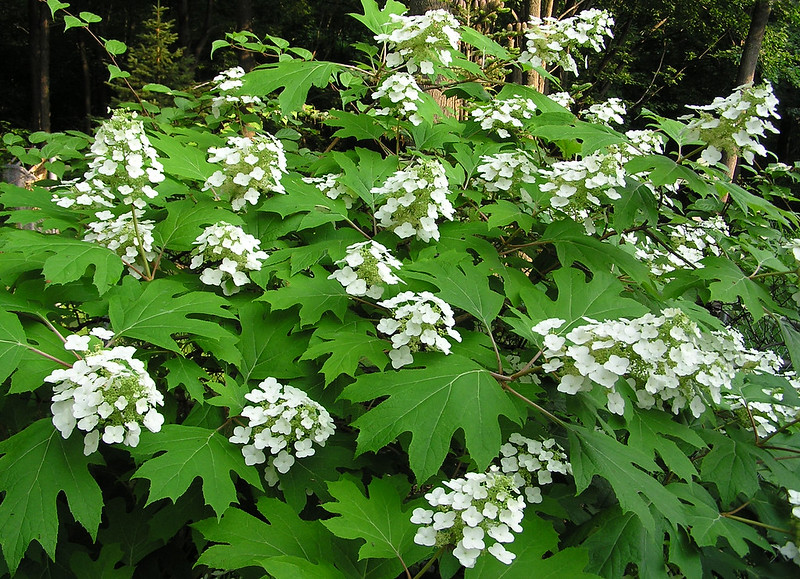
Photo Credit: normanack / Flickr / CC BY 2.0
Native to the southeastern United States, oakleaf hydrangea is known for its large, oak-like leaves and beautiful, cone-shaped flowers. This versatile plant blooms in the late spring to early summer, producing large, showy clusters of white, pink, or red flowers that can be up to 12 inches long.
Its large leaves, which resemble oak leaves, turn a beautiful reddish-purple color in the fall, adding to the plant’s beauty and appeal. In terms of maintenance, the oakleaf hydrangea is relatively easy to care for. It requires regular watering, especially during hot, dry periods, and benefits from regular pruning to maintain its shape and promote healthy growth.
Take advantage of the oakleaf hydrangea’s unique beauty by incorporating it into your landscape design. This shrub can be used as a focal point in your garden or as a backdrop for other plants. You can use it to create a beautiful, natural-looking hedge or screen. Try planting ferns, hostas, and astilbes to complement the oakleaf hydrangea’s foliage and flowers.
Growth habit: Shrub
USDA Hardiness Zone: 5a-9b
Mature size: 4-8 feet tall
Duration: Perennial
Foliage: Deciduous
Sunlight needs: Partial shade to full sun
Soil preferences: Fertile, sandy, or loamy soil
Water needs: Moderate
Potential hazards: Toxic, all its parts are poisonous if ingested by humans and animals
16. Red Maple (Acer rubrum)
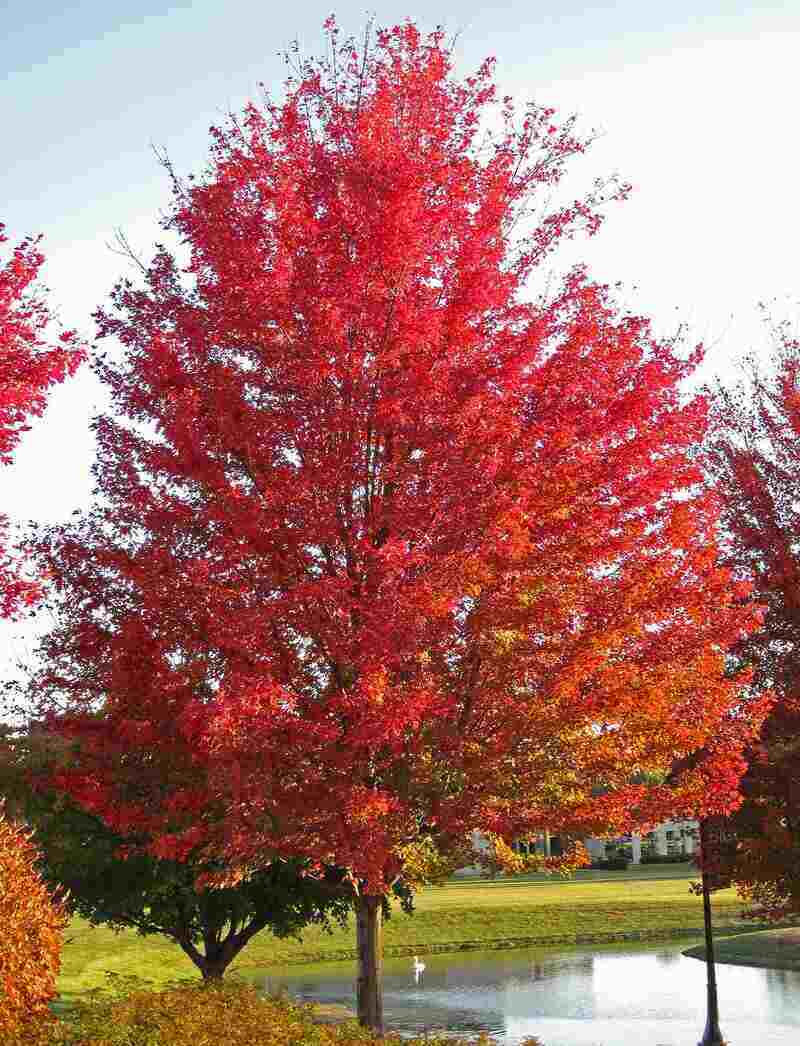
Photo Credit: James St. John / Wikimedia Commons / CC BY 2.0
Known for its striking fall foliage and adaptability to various growing conditions, red maple can be found throughout the Charleston area, particularly in residential areas and along streets and parks. The tree is native to the eastern United States and thrives in moist soils with good drainage, making it a common sight in wetland habitats like swamps and riverbanks.
A spring bloomer, red maple produces small red or yellow flowers in early March before the leaves appear. The flowers provide an important source of early nectar for pollinators like bees and butterflies. In the fall, the leaves of red maple turn vibrant shades of orange, yellow, and red, making it a showstopper in the landscape.
In addition to its aesthetic value, red maple provides important wildlife habitat. The tree’s seeds are a major food source for squirrels, birds, and other animals, and its dense branching structure provides nesting sites and shelter for wildlife.
Growth habit: Tree
USDA Hardiness Zone: 3-9
Mature size: 40-60 feet tall and 25-45 feet wide
Duration: Perennial
Foliage: Deciduous
Sunlight needs: Full sun to partial shade
Soil preferences: Moist to dry, slightly acidic soil
Water needs: High
Potential hazards: Toxic, especially the wilted and dried leaves
17. Sabal Palmetto (Sabal jamesiana)
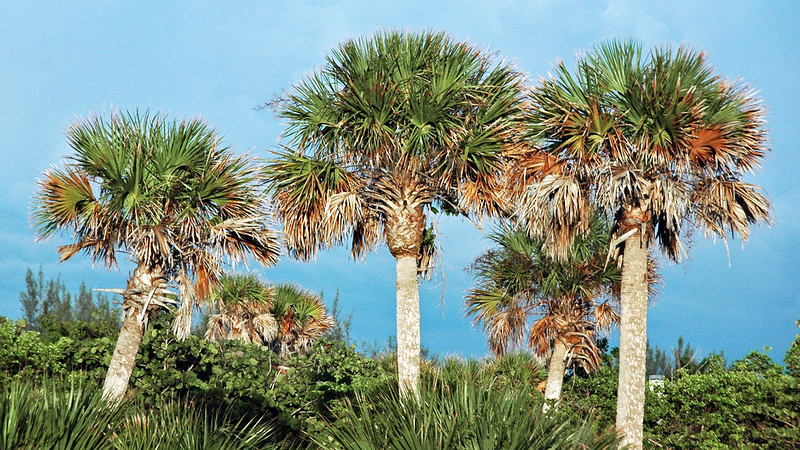
Photo Credit: James St. John / Flickr / CC BY 2.0
Also known as cabbage palm, Sabal palmetto is one of the most iconic trees in Charleston. It is the state tree of South Carolina and can be seen in many public and private landscapes throughout the city. Native to the southeastern United States, this evergreen tree thrives in hot and humid conditions.
The Sabal palmetto is known for its strong, slender trunk and crown of fan-shaped leaves. In the spring, it produces small yellow flowers, followed by small black fruits in the summer. It serves an important ecological function, as the tree provides habitat and food for various wildlife, including birds and insects. In addition, the tree is a resilient species that can withstand strong winds and storms, making it ideal for coastal areas prone to hurricanes.
You can incorporate the Sabal palmetto into your landscape design by planting it in a sunny location with well-draining soil. It is a low-maintenance tree that requires little watering or pruning once established. Planting this palm in groups can create a striking visual effect and provide a sense of tropical tranquility to any outdoor space.
Growth habit: Tree
USDA Hardiness Zone: 7b-11b
Mature size: 20-30 feet tall, but can grow up to 90 feet in the woods
Duration: Perennial
Foliage: Evergreen
Sunlight needs: Partial shade to full sun
Soil preferences: Well-drained, moist, sandy, or loamy soil
Water needs: Moderate – young transplants will need frequent watering for the first 6 months until established
Potential hazards: Toxic to both humans and animals – can be fatal or cause paralysis
18. Sea Oats (Uniola paniculata)
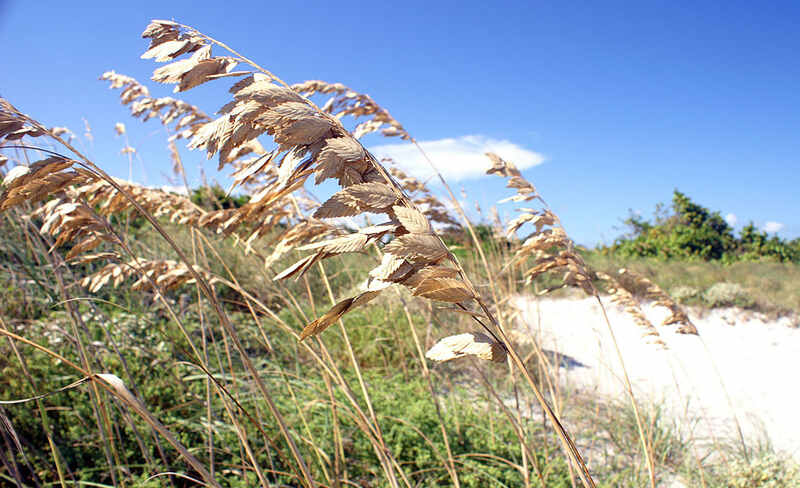
Photo Credit: Daniel di Palma / Wikimedia Commons / CC BY-SA 2.5
A native grass that thrives in coastal regions and sandy soils, sea oats are a perfect fit for beach houses. They grow abundantly on Charleston beaches, including Folly Beach, Isle of Palms, and Sullivan’s Island.
Unlike warm-season grasses, this grass species is well-known for its tall, slender stems reaching 6 feet tall and producing long, delicate seed heads that sway gracefully in the ocean breeze. Typically blooming in late summer or early fall, this salt-tolerant grass produces seeds that can be collected and used for replanting or conservation efforts.
Sea oats play a vital role in stabilizing sand dunes, preventing erosion, and protecting the coastline from the destructive effects of hurricanes and other storms. They also provide essential habitats for wildlife, including birds, insects, and small mammals.
Growth habit: Ornamental grass
USDA Hardiness Zone: 7a-11b
Mature size: 4-6 feet tall
Duration: Perennial
Foliage: Evergreen
Sunlight needs: Full sun
Soil preferences: Well-drained, sandy soil
Water needs: Low
Potential hazards: Non-toxic and edible, although people with allergies and certain sensitivities should not ingest it
19. Southern Lady Fern (Athyrium filix-femina)
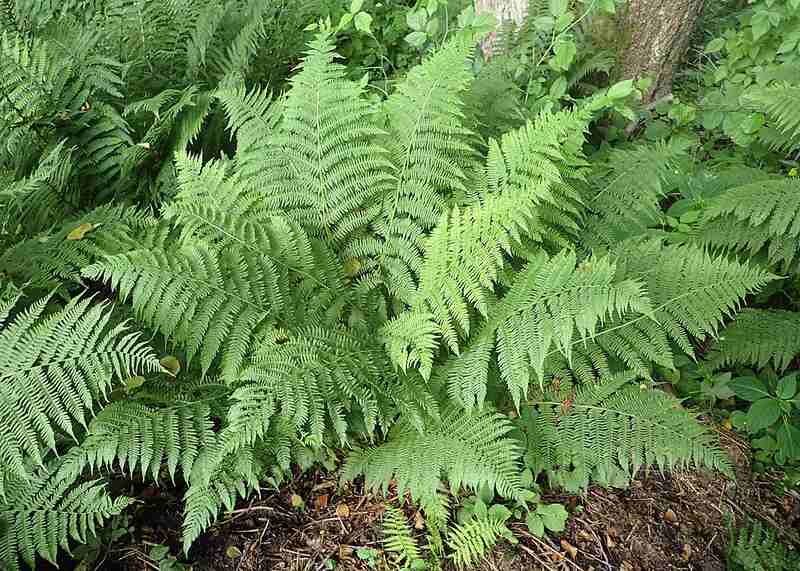
Photo Credit: Krzysztof Ziarnek / Wikimedia Commons / CC BY-SA 4.0
The Southern Lady fern is a lush, green fern that adds a touch of elegance to any garden. It got its name from its delicate fronds, which feature finely dissected leaflets that resemble lace. As a native of the southeastern United States, it’s often found growing in wooded areas and along streams. The fronds emerge in spring and can persist well into fall, providing a long season of interest.
While this fern may not attract many pollinators or wildlife, it does provide a soft, lush texture that can complement other plants in the garden. You can use Southern Lady ferns to create a lush border around a garden bed or as a filler plant in shady areas. They also can be used in container gardens or as a decorative groundcover.
Growth habit: Fern
USDA Hardiness Zone: 6-8
Mature size: 3-6 feet tall
Duration: Perennial
Foliage: Deciduous
Sunlight needs: Full shade to part shade
Soil preferences: Well-drained, moist, fertile, acidic soil
Water needs: Moderate to high – can tolerate occasional flooding
Potential hazards: Toxic, can be fatal if consumed in large amounts
20. Southern Live Oak (Quercus virginiana)
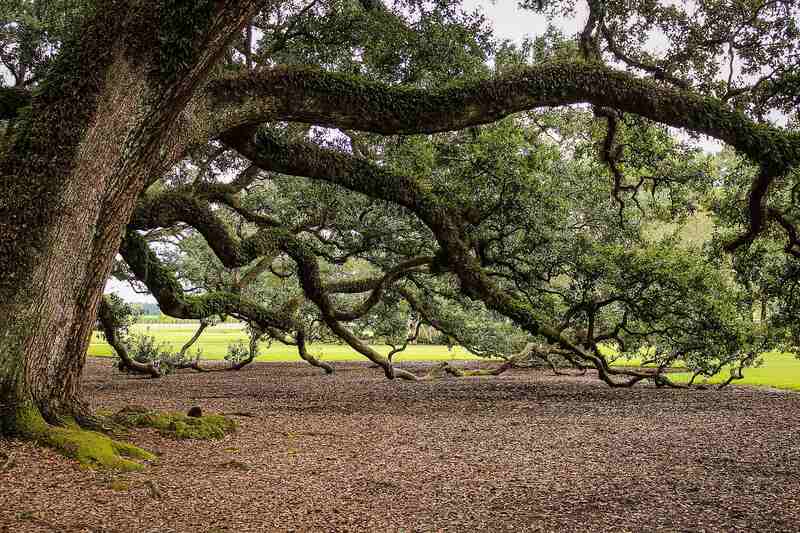
Photo Credit: Pixabay
Native to the southeastern United States, this majestic tree symbolizes the region’s natural beauty. The Southern live oak is a hardy tree with a broad, spreading canopy that provides ample shade on hot summer days.
You can find these evergreen oak trees lining historic streets and providing shade for homes and parks. It’s also a ubiquitous sight in the city’s famed Battery district, where its majestic branches offer a picturesque backdrop for stately antebellum homes.
A keystone species, the Southern live oak provides food and shelter for numerous wildlife, including squirrels, birds, and insects. It’s an important tree for pollinators, as its small, inconspicuous flowers provide nectar for bees and other insects. The tree typically blooms in the spring, with greenish-yellow flowers that give way to small, acorn-like fruits in the fall.
Growth habit: Tree
USDA Hardiness Zone: 8a-10b
Mature size: 40-80 feet tall and 30-100 feet wide
Duration: Perennial
Foliage: Evergreen
Sunlight needs: Partial shade to full sun
Soil preferences: Well-drained, moist, loamy soil
Water needs: Low – From June to September, water it once a week and once a month from November and February. For the other months, gradually increase or decrease the time between each watering session.
Potential hazards: Toxic – although safe to touch, the leaves and acorns can be harmful if ingested by humans and pets
21. Southern Magnolia (Magnolia grandiflora)
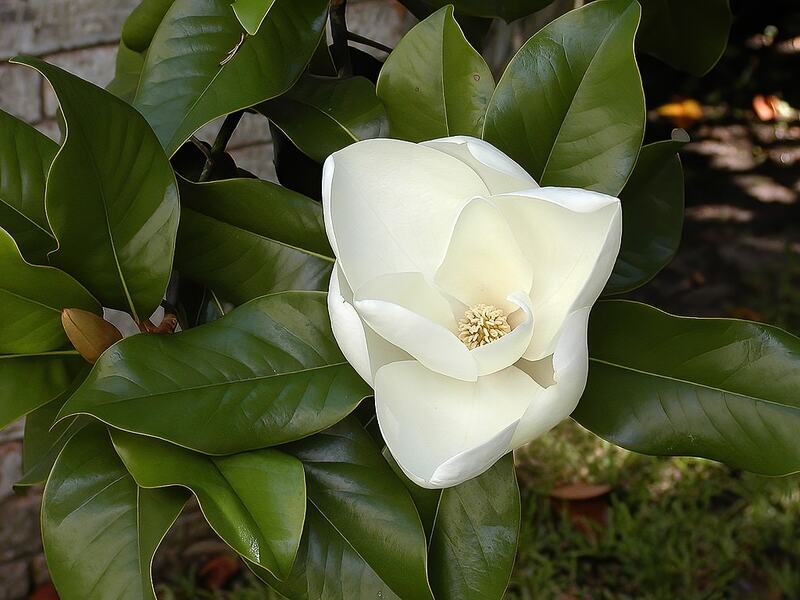
Photo Credit: Jim Evans / Wikimedia Commons / CC BY-SA 4.0
An iconic tree in the American South, the Southern magnolia is a tall evergreen tree with glossy green leaves and large, fragrant white flowers that bloom in the summer. It’s often planted as an ornamental shade tree, but it naturally grows in coastal areas with hot and humid summers. You can use its branches for wreaths and other decorative purposes.
The Southern magnolia’s large flowers are highly attractive to pollinators, including bees and butterflies. Its leaves are a food source for various species of caterpillars, which in turn become food for birds and other wildlife. Additionally, the tree’s thick foliage provides cover and nesting sites for birds.
Growth habit: Tree
USDA Hardiness Zone: 6-10
Mature size: 60-80 feet tall and 30-50 feet wide
Duration: Perennial
Foliage: Evergreen
Sunlight needs: Partial shade to full sun
Soil preferences: Well-drained, moist, fertile soil
Water needs: Low – may need supplemental watering during extended dry spells
Potential hazards: Non-toxic to both humans and animals
22. Southern Wax Myrtle (Myrica cerifera)
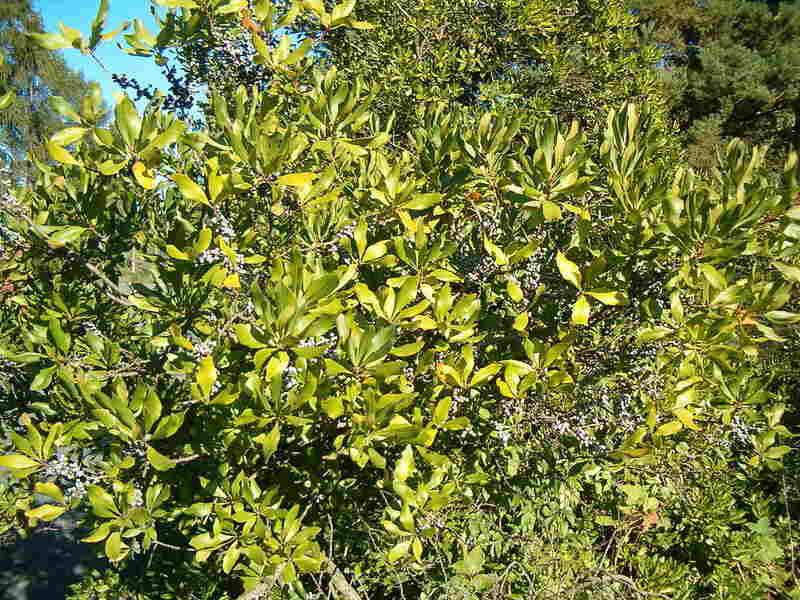
Photo Credit: BotBln / Wikimedia Commons / CC BY-SA 3.0
Southern wax myrtle is a versatile and hardy shrub that is well-suited to Charleston’s coastal environment. This native plant grows in a wide range of habitats, from wetlands to uplands, and is known for its fragrant leaves, which release a spicy aroma when crushed. It’s a popular choice for coastal landscaping because it is highly tolerant of salt spray, drought, and other environmental stressors that can be common in this region.
In late winter and early spring, Southern wax myrtle produces small, inconspicuous flowers that serve as a valuable nectar and pollen source for bees and other pollinators. Later in the season, the plant produces waxy blue berries that are an essential food source for various wildlife, including birds and small mammals. These berries also can be used as candle wax.
Southern wax myrtle can be grown as a hedge or screening plant to provide privacy and visual interest in the landscape. Plus, it can be propagated easily from cuttings.
Growth habit: Tree or shrub
USDA Hardiness Zone: 7-11
Mature size: 20-25 feet tall and 8-10 feet wide
Duration: Perennial
Foliage: Evergreen
Sunlight needs: Partial shade to full sun, but can tolerate full shade
Soil preferences: Can grow well in most soils
Water needs: Moderate – needs watering every two weeks but can tolerate floods and drought once established
Potential hazards: Non-toxic
23. Virginia Creeper (Parthenocissus quinquefolia)
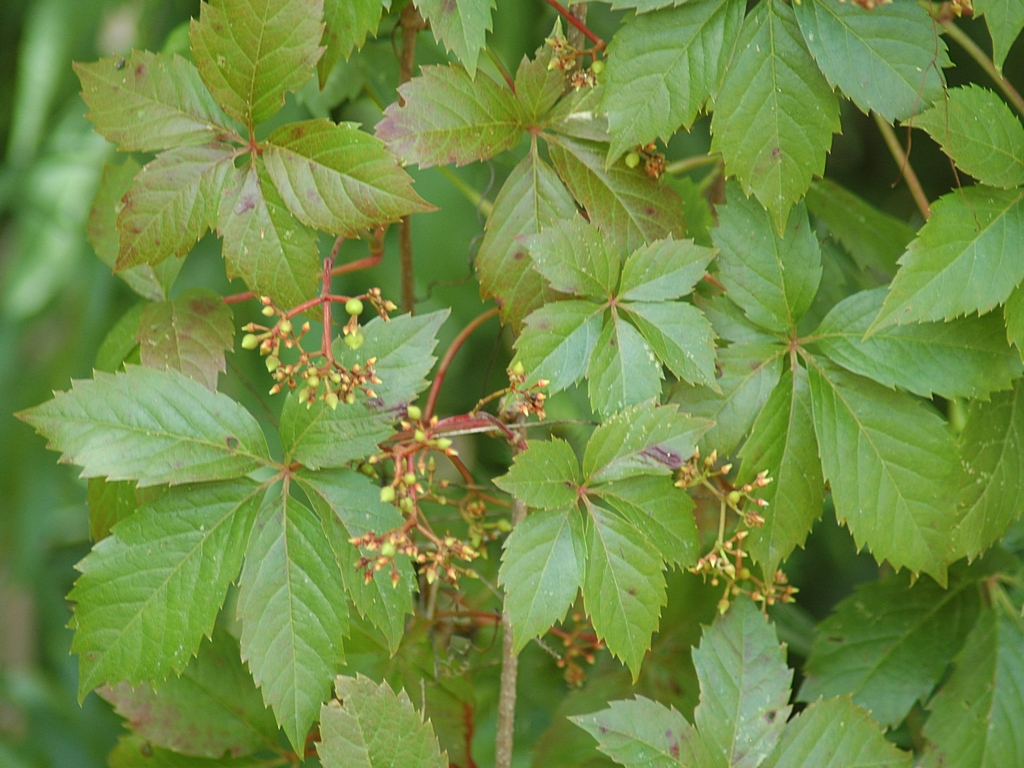
Photo Credit: Linnaeus / Wikimedia Commons / CC BY-SA 3.0
A popular climbing vine native to eastern North America, Virginia creeper is a great choice for homeowners who want a fast-growing plant that can cover walls, fences, and arbors. The vine’s dark green, five-leaflet leaves turn a beautiful red color in autumn, making it a striking addition to any garden.
Virginia creeper is typically found in woodland areas, along streams, and on rocky slopes. It blooms in early summer, producing small green flowers that attract bees and other pollinators. In the fall, the vine produces small blue-black berries that attract birds.
You can plant it near a trellis or other support structure, allowing it to climb and form a dense wall of foliage. It can be trained to grow along the ground, creating a beautiful groundcover. Note that Virginia creeper can become invasive if not managed properly. So, you should keep an eye on its growth and remove any shoots that start to spread too aggressively.
Growth habit: Vine, groundcover
USDA Hardiness Zone: 3-10
Mature size: 30-50 feet tall and 5-10 feet wide
Duration: Perennial
Foliage: Deciduous
Sunlight needs: Partial shade to full sun
Soil preferences: Well-drained, moist soil
Water needs: Low
Potential hazards: Its berries are toxic to both humans and pets, while its sap can cause rashes on most people
24. Virginia Sweetspire (Itea virginica)
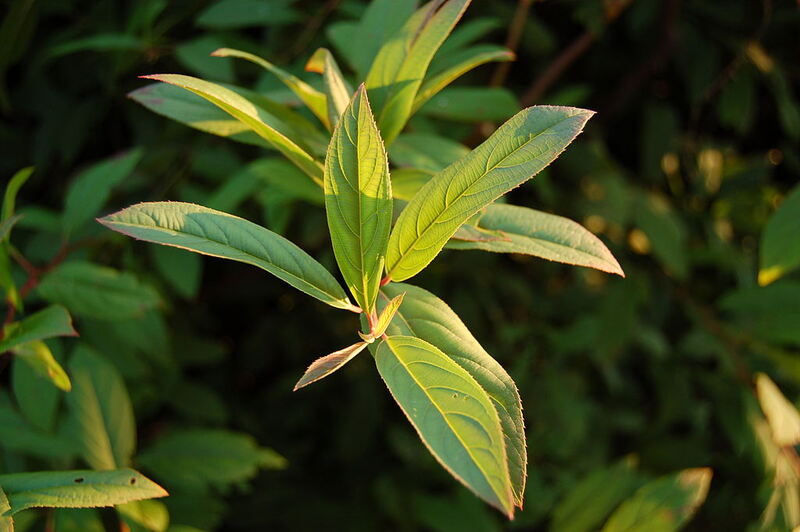
Photo Credit: Derek Ramsey / Wikimedia Commons / CC BY-SA 2.5
Native to the southeastern United States, Virginia sweetspire grows wild in moist woodlands along streams and rivers. But you can find it planted throughout Charleston, including the Audubon Swamp Garden and Magnolia Plantation and Gardens.
This perennial shrub blooms in late spring to early summer, producing fragrant white or pale pink flowers that attract pollinators, including bees and butterflies. The plant’s foliage turns a brilliant red in the fall, adding color to the landscape.
The low-maintenance Virginia sweetspire requires little pruning and is moderately resistant to deer damage, pests, and diseases. To make it even more beautiful in the garden, you can plant it in groups to create a mass of flowers and color. It also makes an excellent hedge or border plant.
Growth habit: Shrub
USDA Hardiness Zone: 5-9
Mature size: 4-8 feet tall and 3-6 feet wide
Duration: Perennial
Foliage: Deciduous to semi-evergreen
Sunlight needs: Partial shade
Soil preferences: Moist, rich soil
Water needs: Low – needs only 1 inch of water per week once established
Potential hazards: Non-toxic
25. Wild Indigo (Baptisia spp.)
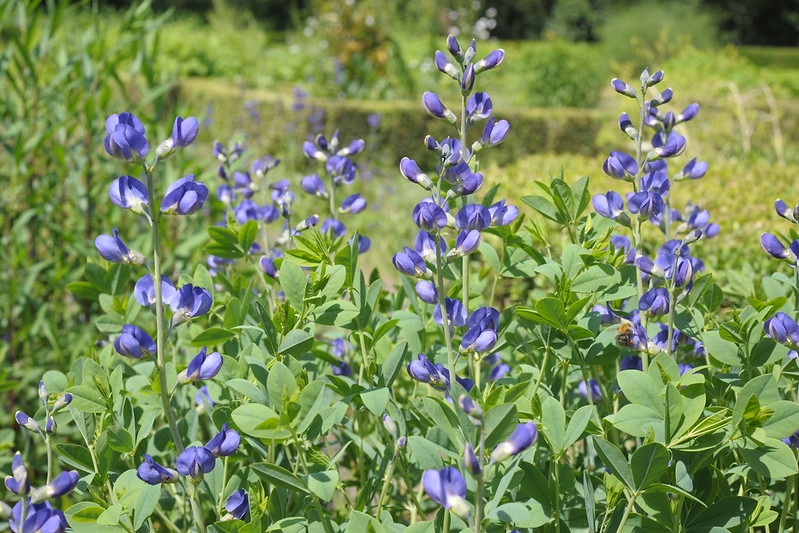
Photo Credit: Joost J. / Flickr / CC BY 2.0
A stunning flowering plant, wild indigo can be found growing wild in woodlands, meadows, and along stream banks. Its showy flowers bloom in late spring to early summer and come in shades of blue, white, and yellow.
The plant is a favorite of many pollinators, including bees and butterflies, and its flowers can be a valuable source of nectar for these insects. Wild indigo also has a symbiotic relationship with certain types of bacteria that live on its roots and help fix nitrogen in the soil.
To encourage healthy growth, fertilize with a slow-release fertilizer in the spring and prune it in the fall to prevent overcrowding.
Growth habit: Herb
USDA Hardiness Zone: 3-9
Mature size: 3-4 feet tall and 3-4 feet wide
Duration: Perennial
Foliage: Deciduous
Sunlight needs: Partial shade to full sun
Soil preferences: Grows well in most soil types but prefers well-drained, moist soil
Water needs: Moderate – it needs watering more than once a week during summer
Potential hazards: Toxic – it can be poisonous to humans and animals if consumed in large amounts and may cause eye irritation and dermatitis
How to Choose Native Plants for Your Charleston Landscape
A city known for its rich history, stunning architecture, and abundant natural beauty, Charleston has a mild climate and diverse landscapes. When choosing native plants for your landscaping, consider the specific conditions of your yard. For example, sea oats are best planted along the coast to help prevent erosion, while the Southern live oak can provide shade and beauty to many historic neighborhoods.
The city’s soil composition varies widely, from sandy coastal soils to heavier clay soils, and some plants may not do well in certain soil types. Similarly, the amount of sunlight your yard receives can impact which plants will thrive, as some native plants require full sun exposure, while others prefer partial shade.
Charleston falls primarily into USDA hardiness zone 8b and 9a, with an average annual minimum temperature range of 15 to 20 degrees Fahrenheit. However, microclimates can vary throughout the city, so it’s crucial to research the specific conditions of your yard and select plants accordingly.
FAQ About Native Charleston Plants
Charleston’s subtropical climate and mild winters make it an excellent place for planting native shrubs and wildflowers year-round. However, the best time to plant these species depends on the specific plants you choose and the local weather conditions.
In general, the ideal time to plant most native shrubs and wildflowers in Charleston is during fall and spring. Planting during this time allows the roots to establish themselves before the hot and dry summer months, reducing the risk of drought stress and increasing the chances of successful growth.
Monitor the weather forecast and soil moisture levels when planning your planting schedule. If the weather is too dry, it’s best to hold off on planting until there is enough moisture in the soil. Similarly, avoid planting during periods of heavy rainfall, as this can cause root rot and other problems.
Native plants are species that have evolved in a specific region and have already adapted to the unique soil, water, and climate conditions. These plants are crucial to the local ecosystem and provide numerous benefits to the environment and the community.
Support the ecosystem: Native plants require less water, fertilizer, and pesticides than non-native species, making them a more sustainable choice for your yard. This means less maintenance and lower costs in the long run, as well as reducing the potential for harm to local waterways and ecosystems.
Support biodiversity: Since native plants are a critical food source for local wildlife, including birds, butterflies, and other pollinators, planting native species in your yard can help create a habitat that supports essential wildlife and preserves biodiversity.
Reduce chemical use: Native species are more resilient to the region’s climate and environmental conditions. They have developed natural defenses against local pests and diseases, making them less susceptible to damage and reducing the need for chemical interventions.
Preserve heritage: Planting native plants can help preserve Charleston’s unique sense of place and cultural heritage. By selecting species that are indigenous to the region, you can create a landscape that reflects the local environment and celebrates the area’s history and identity.
While it’s essential to follow your plants’ water requirements, remember that native plants typically require less water than non-native species once established.
• Avoid watering your native plants too often since overwatering can lead to root rot and other problems. It’s best to water them deeply and infrequently to encourage deep root growth, helping the plants better tolerate dry periods.
• Aim to water your plants to a depth of about 6-8 inches. If you’re not sure how much water your plants are receiving, you can dig a small hole near the base of the plant to check the soil moisture level.
• Water native plants in the early morning or late afternoon when the temperatures are cooler to ensure the water reaches the roots rather than evaporating before it can be absorbed.
• Consider using a drip irrigation system or soaker hose to water your native plants. These methods deliver water directly to the soil, lessening the chances of water being lost to evaporation and runoff.
Where to Find Native Plants in Charleston
Charleston is home to a diverse and wide array of native plant species, from coastal shrubs to woodland wildflowers. Luckily, there are several local nurseries and plant resources to help you find the perfect native plants for your yard.
You can start your search with the South Carolina Native Plant Society. Their website offers a wealth of information on native plants and an extensive database of species well-suited to Charleston’s climate and soil conditions. They have a list of recommended nurseries and plant suppliers in the area, including:
- Bottle Tree Gardening
- Milkweed Madness
- Native Plant Landscapes
- Roots & Shoots Nursery
- SCNPS: Lowcountry Chapter
Before adding indigenous flora to your garden, remember to factor in the unique ecological circumstances of your yard, including your turf variety, soil quality, water drainage, and amount of sunlight. Also, avoid transplanting native plants from the wild, as it can harm local ecosystems and disrupt natural habitats.
Although native plants don’t require much maintenance once established, getting your lawn ready and planting new flora may require some effort. Plus, with Charleston’s humidity, you can quickly turn into a sweaty mess.
So if you’d rather spend time at Sullivan’s Island Beach instead of working on your garden, reach out to a Charleston landscaping pro today.
Main Photo by: Pixabay